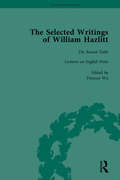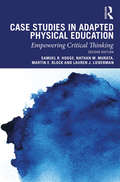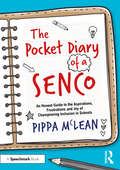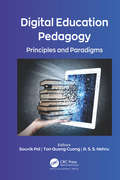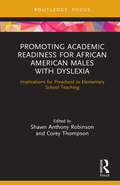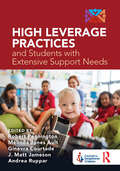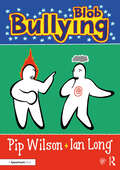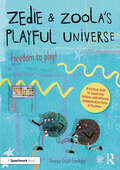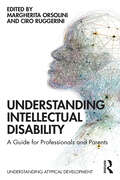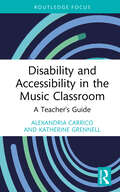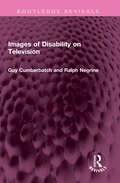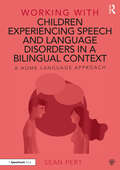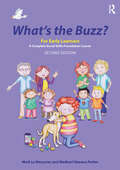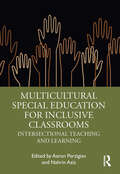- Table View
- List View
The Selected Writings of William Hazlitt Vol 2
by Duncan Wu Tom Paulin David Bromwich Stanley Jones Roy ParkWilliam Hazlitt is viewed by many as one of the most distinguished of the non-fiction prose writers to emerge from the Romantic period. This nine-volume edition collects all his major works in complete form.
Case Studies in Adapted Physical Education: Empowering Critical Thinking
by Samuel Hodge Nathan Murata Martin Block Lauren LiebermanCovering self-contained adapted physical education classes, general physical education programs, and youth sports and community recreation, this book presents a series of case studies of teaching individuals of varied ability and disability in physicalactivity settings. Outlining realistic scenarios, it encourages an interactive, problem-solving teaching and learning style and the development of critical thinking skills. Now in a fully revised and updated second edition, the book covers a wide range of different professional issues, themes, disabilities, and conditions, from assessment and behavior management processes to working with students with intellectual disabilities, motor difficulties, chronic illness, or obesity. Each case study includes questions that challenge the reader to ref lect on the practical issues involved and how to build inclusive teaching strategies. This book is valuable reading for all physical education students, teacher candidates, and novice and experienced teachers looking to deepen their understanding of adapted physical education and to improve their professional practice. It is an essential companion to any adapted physical education or physical activity course.
The Selected Writings of William Hazlitt Vol 2
by Duncan Wu Tom Paulin David Bromwich Stanley Jones Roy ParkWilliam Hazlitt is viewed by many as one of the most distinguished of the non-fiction prose writers to emerge from the Romantic period. This nine-volume edition collects all his major works in complete form.
The Pocket Diary of a SENCO: An Honest Guide to the Aspirations, Frustrations and Joys of Championing Inclusion in Schools
by Pippa McLeanThe Pocket Diary of a SENCO spans a typical school year and includes hopeful and often humorous diary entries that share the authentic aspirations, joys, and frustrations of championing inclusion and working in the role of a SENCO. Grounded in real-life experiences and day-to-day practice, Pippa McLean describes the experiences of a SENCO and the reality of SEND provision in school, drawing out the personal characteristics and values that schools can foster to support inclusive practice and nurture positive relationships between children, parents, and colleagues. Diary extracts across the months range from ‘Be ready to hit the road’, ‘Be gentle on yourself’, to ‘Be a culture builder' and ‘Be an advocate'. Each entry is followed by reflective questions and space for the reader to jot down their own thoughts, as well as ‘monthly musings’ to support their own professional development. Written in a truly conversational style, this essential pocket diary captures the reality of SEND provision in schools and will be relatable to many. It is valuable reading for SENCOs, teachers, support staff and trainees who wish to enrich their learning around inclusive practice and engage reflectively within their busy lives.
Digital Education Pedagogy: Principles and Paradigms
by Souvik Pal Ton Quang Cuong R. S. S. NehruThis volume brings together advanced concepts from leading academic scientists, educationalists, administrative policymakers, and researchers on their experiences and research results on many aspects of digital educational methods and teaching practices. It provides an interdisciplinary compilation of recent innovations, trends, and concerns as well as the challenges encountered and solutions adopted in the fields of digital pedagogies and educational design.It is becoming increasingly important to develop adaptive, robust, scalable, and digital teaching-learning mechanisms in academics. This volume addresses this need by discussing the advancements in flipped and blended learning, student- and teacher-centric learning in technical institutes, critical digital pedagogies, and the complex analyses and collaborations with organizations outside the academy. This book also deals with protocols for educational and administrative policies, IoT-based teaching-learning methodology, teaching education and the process of assessment, testing and evaluation, integration of technology with digital education, and different case study-based approaches in digital teaching-learning methodology.
Digital Education Pedagogy: Principles and Paradigms
by Souvik Pal, Ton Quang Cuong and R. S. S. NehruThis volume brings together advanced concepts from leading academic scientists, educationalists, administrative policymakers, and researchers on their experiences and research results on many aspects of digital educational methods and teaching practices. It provides an interdisciplinary compilation of recent innovations, trends, and concerns as well as the challenges encountered and solutions adopted in the fields of digital pedagogies and educational design.It is becoming increasingly important to develop adaptive, robust, scalable, and digital teaching-learning mechanisms in academics. This volume addresses this need by discussing the advancements in flipped and blended learning, student- and teacher-centric learning in technical institutes, critical digital pedagogies, and the complex analyses and collaborations with organizations outside the academy. This book also deals with protocols for educational and administrative policies, IoT-based teaching-learning methodology, teaching education and the process of assessment, testing and evaluation, integration of technology with digital education, and different case study-based approaches in digital teaching-learning methodology.
Promoting Academic Readiness for African American Males with Dyslexia: Implications for Preschool to Elementary School Teaching (Routledge Research in Educational Equality and Diversity)
by Shawn Anthony Robinson Corey ThompsonThis timely book tackles underlying issues that see disproportionate numbers of African American males with dyslexia undiagnosed, untreated, and falling behind their peers in terms of literacy achievement. Considering factors including dialectic linguistic difference, limited phonological awareness, and the intersectionality of gender, language, and race, the studies included in this volume illustrate how classroom practices at preschool and elementary levels are failing to support students at risk of reading and writing difficulties. Promoting Academic Readiness for African American Males with Dyslexia shows that it is possible to provide every girl and boy, and particularly African American boys with effective support and appropriate interventions enabling them to read at a level that is conducive to ongoing academic performance and success. This, argue the authors of this volume, is vital to the social, emotional, moral, and intellectual development of our society. This edited volume was originally published as a special issue of Reading & Writing Quarterly: Overcoming Learning Difficulties. It will be of great interest to graduate and postgraduate students, researchers, and academics in the field of African-American Education, Educational Equity, Race studies, Multiple learning difficulties and Literacy development.
Promoting Academic Readiness for African American Males with Dyslexia: Implications for Preschool to Elementary School Teaching (Routledge Research in Educational Equality and Diversity)
by Shawn Anthony Robinson Corey ThompsonThis timely book tackles underlying issues that see disproportionate numbers of African American males with dyslexia undiagnosed, untreated, and falling behind their peers in terms of literacy achievement. Considering factors including dialectic linguistic difference, limited phonological awareness, and the intersectionality of gender, language, and race, the studies included in this volume illustrate how classroom practices at preschool and elementary levels are failing to support students at risk of reading and writing difficulties. Promoting Academic Readiness for African American Males with Dyslexia shows that it is possible to provide every girl and boy, and particularly African American boys with effective support and appropriate interventions enabling them to read at a level that is conducive to ongoing academic performance and success. This, argue the authors of this volume, is vital to the social, emotional, moral, and intellectual development of our society. This edited volume was originally published as a special issue of Reading & Writing Quarterly: Overcoming Learning Difficulties. It will be of great interest to graduate and postgraduate students, researchers, and academics in the field of African-American Education, Educational Equity, Race studies, Multiple learning difficulties and Literacy development.
High Leverage Practices and Students with Extensive Support Needs
by Robert Pennington Melinda Jones Ault Ginevra Courtade J. Matt Jameson Andrea RupparBuilding on the formative work of High Leverage Practices (HLP) for Inclusive Classrooms, this critical companion explores how HLP can be applied to the education of students with extensive support needs (ESN). Each chapter walks readers through a different HLP, exploring its implications for students with ESN and aligning it with current practice, supports, and terminology. Edited by researchers and teacher educators with decades of experience in serving students with ESN and their teachers, this book is packed with rich examples of and detailed supports for implementing HLPs to ensure every student has access to all aspects of their school community.
High Leverage Practices and Students with Extensive Support Needs
by Robert Pennington Melinda Jones Ault Ginevra Courtade J. Matt Jameson Andrea RupparBuilding on the formative work of High Leverage Practices (HLP) for Inclusive Classrooms, this critical companion explores how HLP can be applied to the education of students with extensive support needs (ESN). Each chapter walks readers through a different HLP, exploring its implications for students with ESN and aligning it with current practice, supports, and terminology. Edited by researchers and teacher educators with decades of experience in serving students with ESN and their teachers, this book is packed with rich examples of and detailed supports for implementing HLPs to ensure every student has access to all aspects of their school community.
Blob Bullying (Blobs)
by Pip Wilson Ian LongThis practical and accessible resource contains a wealth of discussion sheets and games to help victims of bullying reflect and talk about their experiences and feelings using the internationally familiar Blob figures. Diverse and inclusive, the Blob figures are a proven way to help children and adults share their feelings and experiences. Without age, culture or gender, they enable the individual to focus on feelings and body language. In this book, the Blobs explore bullying. From Blob Trees to Bingo games, cards and emotional scales, the Blobs provide a visual structure that allows children, teenagers and adults to open up about being bullied. Offering unique activities that help scaffold conversations for people of all ages and abilities, this is an essential resource for teachers, teaching assistants, youth and social workers, psychologists, counsellors and all those who work with and have caring responsibilities for others.
Blob Bullying (Blobs)
by Pip Wilson Ian LongThis practical and accessible resource contains a wealth of discussion sheets and games to help victims of bullying reflect and talk about their experiences and feelings using the internationally familiar Blob figures. Diverse and inclusive, the Blob figures are a proven way to help children and adults share their feelings and experiences. Without age, culture or gender, they enable the individual to focus on feelings and body language. In this book, the Blobs explore bullying. From Blob Trees to Bingo games, cards and emotional scales, the Blobs provide a visual structure that allows children, teenagers and adults to open up about being bullied. Offering unique activities that help scaffold conversations for people of all ages and abilities, this is an essential resource for teachers, teaching assistants, youth and social workers, psychologists, counsellors and all those who work with and have caring responsibilities for others.
Zedie and Zoola Light Up the Night: A Storybook to Help Children Learn About Communication Differences (Zedie and Zoola’s Playful Universe)
by Vanessa Lloyd-EsenkayaThis beautifully illustrated, inclusive storybook helps children to understand that some people find talking difficult, and that we can help by listening and thinking of different ways to communicate. One day, the light in Zedie and Zoola’s lighthouse goes out, putting visiting boats in danger. They set off on an adventure to find enough glorms to bring light back to their village. On their adventure Zedie and Zoola see lots of exciting places and, with the help of new friends, they manage to find all the glorms they need. At the end of their trip, they have lots of new experiences to talk about. Zedie & Zoola Light Up the Night draws on themes relating to friendships, neurodiversity, participation, and advocacy and is designed to be used alongside: Zedie & Zoola’s Playtime Cards – a pack of 25 cards containing ideas for fun playground games that encourage children with different communication styles to play together. Zedie & Zoola’s Playful Universe – an evidence-based guide offering additional advice for adults to use the cards effectively, with helpful contextual information to assist in making playtimes more accessible. This is an essential resource for parents, primary school teachers, and speech and language therapists, as well as anyone looking for new ways to foster an inclusive environment to help children aged 6-9 with different communication styles engage and play with their peers.
Zedie and Zoola’s Playful Universe: A Practical Guide to Supporting Children with Different Communication Styles at Playtime (Zedie and Zoola’s Playful Universe)
by Vanessa Lloyd-EsenkayaPlaytime is essential for children’s wellbeing and provides key opportunities to make friends. Yet for some children, unstructured play can present real challenges. This beautifully illustrated guide is designed to be used alongside: Zedie & Zoola’s Playtime Cards – a pack of 25 cards containing ideas for fun playground games that draw from Zedie & Zoola’s Playful Universe and encourage children with different communication styles to play together. Zedie & Zoola Light Up the Night – a colourful storybook, which draws on themes relating to friendships, neurodiversity, participation, and advocacy. The cards and storybook explore the topic of communication differences through engaging characters and games. This accompanying guide offers additional advice for adults to use the cards effectively, with helpful contextual information to assist in making playtimes more accessible for children with communication conditions. This is an essential resource for parents, primary school teachers, and speech and language therapists, as well as anyone looking for new ways to foster an inclusive environment to help children aged 6-9 with different communication styles engage and play with their peers.
Understanding Intellectual Disability: A Guide for Professionals and Parents (Understanding Atypical Development)
by Margherita Orsolini Ciro RuggeriniUnderstanding Intellectual Disability: A Guide for Professionals and Parents supports professionals and parents in understanding critical concepts, correct assessment procedures, delicate and science-infused communication practices and treatment methods concerning children with intellectual disabilities. From a professional perspective, this book relies on developmental neuropsychology and psychiatry to describe relevant measures and qualitative observations when making a diagnosis and explores the importance of involving parents in the reconstruction of a child’s developmental history. From a parent’s perspective, the book shows how enriched environments can empower children’s learning processes, and how working with patients, families, and organizations providing care and treatment services can be effectively integrated with attachment theory. Throughout seven chapters, the book offers an exploration of diagnostic procedures, new insights on the concept of intelligence and the role of communication and secure attachment in the mind’s construction. With expertise from noteworthy scholars in the field, the reader is given an overview of in-depth assessment and intervention practices illustrated by several case studies and examples, as well as a lifespan perspective from a Human Rights Model of disability. Understanding Intellectual Disability is an accessible guide offering an up-to-date vision of intellectual disability and is essential for psychologists, health care professionals, special educators, students in clinical psychology, and parents. Things are connected through invisible bonds: you cannot pluck a flower without unsettling a star. Galileo Galilei
Understanding Intellectual Disability: A Guide for Professionals and Parents (Understanding Atypical Development)
by Margherita Orsolini Ciro RuggeriniUnderstanding Intellectual Disability: A Guide for Professionals and Parents supports professionals and parents in understanding critical concepts, correct assessment procedures, delicate and science-infused communication practices and treatment methods concerning children with intellectual disabilities. From a professional perspective, this book relies on developmental neuropsychology and psychiatry to describe relevant measures and qualitative observations when making a diagnosis and explores the importance of involving parents in the reconstruction of a child’s developmental history. From a parent’s perspective, the book shows how enriched environments can empower children’s learning processes, and how working with patients, families, and organizations providing care and treatment services can be effectively integrated with attachment theory. Throughout seven chapters, the book offers an exploration of diagnostic procedures, new insights on the concept of intelligence and the role of communication and secure attachment in the mind’s construction. With expertise from noteworthy scholars in the field, the reader is given an overview of in-depth assessment and intervention practices illustrated by several case studies and examples, as well as a lifespan perspective from a Human Rights Model of disability. Understanding Intellectual Disability is an accessible guide offering an up-to-date vision of intellectual disability and is essential for psychologists, health care professionals, special educators, students in clinical psychology, and parents. Things are connected through invisible bonds: you cannot pluck a flower without unsettling a star. Galileo Galilei
Disability and Accessibility in the Music Classroom: A Teacher's Guide (Modern Musicology and the College Classroom)
by Alexandria Carrico Katherine GrennellDisability and Accessibility in the Music Classroom provides college music history instructors with a concise guide on how to create an accessible and inclusive classroom environment. In addition to providing a concise overview of disability studies, highlighting definitions, theories, and national and international policies related to disability, this book offers practical applications for implementing accessibility measures in the music history classroom. The latter half of this text provides case studies of well-known disabled composers and musicians from the Western Art Music canon from the Middle Ages to the Twentieth Century as well as popular music genres, such as the blues, jazz, R&B, pop, country, and hip hop. These examples provide opportunities to integrate discussions of disability into a standard music history curriculum.
Disability and Accessibility in the Music Classroom: A Teacher's Guide (Modern Musicology and the College Classroom)
by Alexandria Carrico Katherine GrennellDisability and Accessibility in the Music Classroom provides college music history instructors with a concise guide on how to create an accessible and inclusive classroom environment. In addition to providing a concise overview of disability studies, highlighting definitions, theories, and national and international policies related to disability, this book offers practical applications for implementing accessibility measures in the music history classroom. The latter half of this text provides case studies of well-known disabled composers and musicians from the Western Art Music canon from the Middle Ages to the Twentieth Century as well as popular music genres, such as the blues, jazz, R&B, pop, country, and hip hop. These examples provide opportunities to integrate discussions of disability into a standard music history curriculum.
Images of Disability on Television (Routledge Revivals)
by Guy Cumberbatch Ralph NegrineFirst published in 1992, Images of Disability on Television examines the frequency and nature of disability on British and American television and how it is perceived and presented by programme makers. Attitudes held by those closest to the issues – disabled people, their carers, and television producers and writers – are presented as the result of interviews and discussions. There is an increasingly strong sentiment that television has got it wrong as far as disability is concerned and does not play its proper role in allowing the non-disabled to understand fully the world of disabled people. This book provides information to promote greater understanding of the needs of the disabled people in television portrayal and opens up possibilities for a change in attitudes. It will be valuable reading for students, researchers and lecturers in the social sciences, communication studies, and media studies.
Images of Disability on Television (Routledge Revivals)
by Guy Cumberbatch Ralph NegrineFirst published in 1992, Images of Disability on Television examines the frequency and nature of disability on British and American television and how it is perceived and presented by programme makers. Attitudes held by those closest to the issues – disabled people, their carers, and television producers and writers – are presented as the result of interviews and discussions. There is an increasingly strong sentiment that television has got it wrong as far as disability is concerned and does not play its proper role in allowing the non-disabled to understand fully the world of disabled people. This book provides information to promote greater understanding of the needs of the disabled people in television portrayal and opens up possibilities for a change in attitudes. It will be valuable reading for students, researchers and lecturers in the social sciences, communication studies, and media studies.
Working with Children Experiencing Speech and Language Disorders in a Bilingual Context: A Home Language Approach (Working With)
by Sean PertThe complexity of speech and language disorders can be daunting in a monolingual context. When working with a bilingual child assessment and intervention may appear to be even more complicated. In this book Sean Pert provides the reader with the tools needed to overcome this perception and develop skills in working in a language that they don’t share with the client. By adopting a home language first approach the book discusses how to: identify diversity from disorder introduce effective approaches in line with the best clinical practice work successfully alongside interpreters make assessments and plan interventions set goals for therapy. At the heart of the text is the therapist creating essential partnerships with parents and truly valuing the bilingualism, culture and identity of the child. This leads to better outcomes, not only in speech, language and communication, but also in self-esteem, mental health, social participation and educational and employment success. The book concludes with a handy toolkit of resources including quizzes, case studies and printable extras making it the perfect resource for both experienced and newly qualified practitioners with bilingual and multilingual children in their care.
Working with Children Experiencing Speech and Language Disorders in a Bilingual Context: A Home Language Approach (Working With)
by Sean PertThe complexity of speech and language disorders can be daunting in a monolingual context. When working with a bilingual child assessment and intervention may appear to be even more complicated. In this book Sean Pert provides the reader with the tools needed to overcome this perception and develop skills in working in a language that they don’t share with the client. By adopting a home language first approach the book discusses how to: identify diversity from disorder introduce effective approaches in line with the best clinical practice work successfully alongside interpreters make assessments and plan interventions set goals for therapy. At the heart of the text is the therapist creating essential partnerships with parents and truly valuing the bilingualism, culture and identity of the child. This leads to better outcomes, not only in speech, language and communication, but also in self-esteem, mental health, social participation and educational and employment success. The book concludes with a handy toolkit of resources including quizzes, case studies and printable extras making it the perfect resource for both experienced and newly qualified practitioners with bilingual and multilingual children in their care.
What's the Buzz? For Early Learners: A Complete Social Skills Foundation Course
by Mark Le Messurier Madhavi Nawana ParkerFor many, social thinking is hard-wired at birth and strengthens naturally through experiences. However, for a variety of reasons, some children find it harder to think and develop socially. What’s the Buzz? For Early Learners 2e is a fully updated social and emotional literacy foundation programme for children aged 4–8 years. Following the global popularity of the first edition of the What’s the Buzz programme, this revised edition leads children through Archie’s adventures over 16 lessons, as he encounters a range of social and emotional dilemmas. Through evidence-based activities, discussion, role-play, games, and explicit social skill instruction, children learn how develop positive problem-solving skills to transfer into their everyday lives. It also focuses on developing an understanding of a diversity of ability and cultural background, helping to teach children how to ‘read’ the emotional needs of others, show empathy, and increase self-awareness. Clinically trialled and evaluated, this lively resource has been used successfully around the globe to teach children in building and maintaining healthy relationships, understanding and regulating their own emotions, and generally becoming thoughtful citizens. Enriched with visual materials and activity sheets to accompany each lesson, this is a must-have resource for allied health professionals and teachers in both special and mainstream settings. It is suitable for whole-class or small-group intervention.
What's the Buzz? For Early Learners: A Complete Social Skills Foundation Course
by Mark Le Messurier Madhavi Nawana ParkerFor many, social thinking is hard-wired at birth and strengthens naturally through experiences. However, for a variety of reasons, some children find it harder to think and develop socially. What’s the Buzz? For Early Learners 2e is a fully updated social and emotional literacy foundation programme for children aged 4–8 years. Following the global popularity of the first edition of the What’s the Buzz programme, this revised edition leads children through Archie’s adventures over 16 lessons, as he encounters a range of social and emotional dilemmas. Through evidence-based activities, discussion, role-play, games, and explicit social skill instruction, children learn how develop positive problem-solving skills to transfer into their everyday lives. It also focuses on developing an understanding of a diversity of ability and cultural background, helping to teach children how to ‘read’ the emotional needs of others, show empathy, and increase self-awareness. Clinically trialled and evaluated, this lively resource has been used successfully around the globe to teach children in building and maintaining healthy relationships, understanding and regulating their own emotions, and generally becoming thoughtful citizens. Enriched with visual materials and activity sheets to accompany each lesson, this is a must-have resource for allied health professionals and teachers in both special and mainstream settings. It is suitable for whole-class or small-group intervention.
Multicultural Special Education for Inclusive Classrooms: Intersectional Teaching and Learning
by Aaron Perzigian Nahrin AzizThis book provides a comprehensive exploration of critical topics in multicultural special education. Filled with case studies, objectives, and summaries to support deeper learning, the chapters discuss privilege and power in K-12 school systems, effective and differentiated instruction, culturally competent IEPs and transition plans, and appropriate assessment. Drawing from seminal multicultural education and culturally sustaining pedagogies, this essential text helps educators develop the skills necessary to affirm and honor identities while meeting the instructional needs of culturally diverse students with disabilities.
